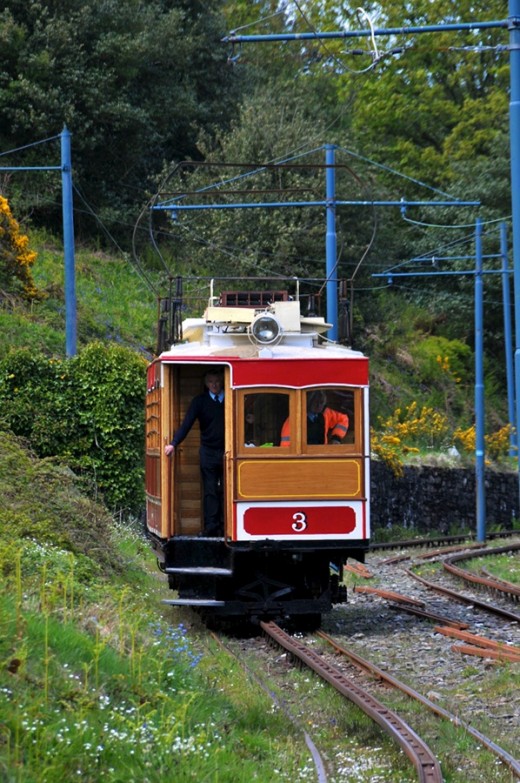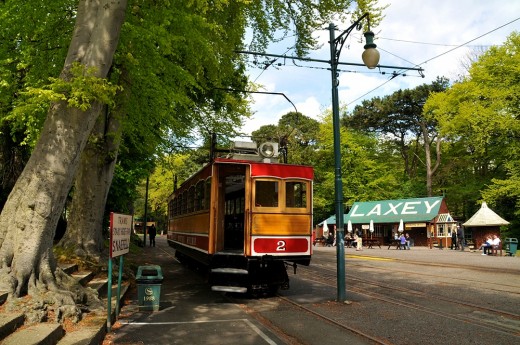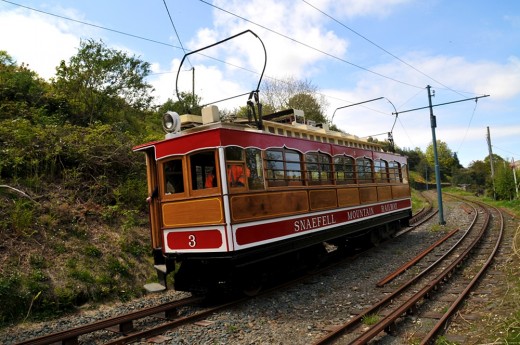Discover the Snaefell Mountain Railway

A Pioneering Electric Railway to the Summit of Snaefell
Snaefell Mountain Railway - A Brief History. The story of the pioneering Snaefell Mountain Railway really starts with the Isle of Man Tramways & Electric Power Company (later to become the Manx Electric Railway in 1902), which had built a 3' gauge tramway from the capital Douglas, 2-¼ miles to Groudle Glen in 1893. This line was extended the following year a further 5-¾ miles to the village of Laxey.
Now Laxey was a mining village on the island's east, and a very popular destination with the Victorian tourists with its lead and zinc mines, the 'Lady Isobella', the largest waterwheel in the world, and scenic Laxey valley with the island's only mountain Snaefell (Scandinavian for snow mountain) at the head of the valley.
From the summit at 2036ft, on a clear day, one can take in panoramic views of England, Scotland, Wales, Ireland and a large part of the island too. For the early intrepid Victorian visitor the accent to the summit meant a climb on either foot or horseback.
The Isle of Man Tramways & Electric Power Company, who built the line from Douglas to Laxey, announced at the end of 1894 that it planned to build a electric railway to the summit of Snaefell from Laxey, so the majestic experience could be shared not by a few, but by thousands. This news came as a great surprise to railway world, a steam powered mountain railway – let alone an electric powered one had not be attempted in the British Isles. A company called the Snaefell Mountain Railway Association was formed to construct the 4-½ mile long line to the summit, and work started in earnest in January 1895.
A gauge of 3ft-6” was adopted, which was unusual for the island as the Manx 'standard gauge' is 3ft. The extra six inches was to accommodate the Fell incline system, which is a double-headed bull rail between the running rails that the tramcar grips by means of additional horizontal driving wheels. However, by the time the line was completed, electric traction technology had advanced so much tramcars could now tackle the fearsome 1 in 12 grades totally unaided. So, the Fell gear was dispensed with, although the centre Fell rail was retained as a braking rail, as the problem was not so much going up, but controlling the tricky decent back down again.
To speed up construction, a fourth temporary rail was added to make a 3ft gauge track, as the island's most powerful steam locomotive 'Caledonia' was hired from the Manx Northern Railway to speed up construction. The Dubs built 0-6-0T engine of 1885, was transported by sea from Ramsey, and dragged up though Laxey village to the new tramway.

Panoramic Views of England, Scotland, Wales, Ireland and the Isle of Man
Taking a mere seven months to construct, and after an official inspection, the line was duly opened for public service on 21 August 1895. To operate the line, G. F. Milnes & Co of Birkenhead supplied six passenger tramcars. The tramcar bodies were almost identical to the four tramcars (No. 10 to No. 13) supplied to the Isle of Man Tramways & Electric Power Company the same year.
The Snaefell tramcars have 48 seats, and were originally supplied without glazing to the passenger windows, but the bracing sea air was too much for the Victorian holidaymakers, and sliding windows were added the following year. However, this caused a 'greenhouse' effect, and so clerestory roofs were added the following winter.
The tramway's seventh piece of motive power 'Maria' the coal tram was real Manx oddball. 'Maria' was used primarily for freight work, and each winter she would laboriously carry all of next season's coal supply up to the line's only power station situation just over half way up the line on a lonely wind-swept site just below the Bungalow station. The coal tram was built locally, and had no power bogies of her own, and would borrow the bogies and control equipment of SMR tramcar No. 5 each winter. Once the all island power supply was switched on in 1934, the line's power station closed, and 'Maria' was made redundant and left to rot next to the Laxey carshed.
While the Snaefell line is used mainly by tourists wanting to travel to the summit, since 1950s, there has been another operator using the tramway. The Air Ministry, who became the Civil Aviation Authority, operate and service one of the radar/communications masts on the summit of Snaefell all year round, for which they operate their own small fleet of self-propelled diesel railcars. Diesel power is required as the traction wires are removed from the upper section of the mountain to prevent frost and wind damage during the winter months.
The system has hardly changed in over 100 years of operation apart from the fitting of rheostatic braking to the six passenger tramcars in the 1970s, which has eliminated the use of the Fell rail for braking, but is retained for emergency use only, and more recently a track replacement programme has been instigated.
The impressive stone castellated hotel on the summit was lost in a fire in 1982, but a replacement has since been built. Meanwhile, the SMR 1895 carshed at Laxey was replace with a more modern building with maintenance facilities in 1995.
What the Snaefell Mountain Railway lacks in interesting rolling stock, it more than makes up for in dramatic and stunning scenery on route, and the fantastic vista from the summit. As most locals know, it's only worth travelling on the tramway to summit on a clear day, and even then, the unpredictable Manx weather can change in minutes leaving the upper section of Snaefell mountain shrouded in a thick cape of grey mist with zero visibility.
© David Lloyd-Jones 2010

Useful Links :
- Manx Electric Railway Society includes the Snaefell Mountain Railway
- Snaefell Mountain Railway 2011 - iombusandrail.info
The Official bus and rail timetable and information site for the Isle of Man - updated frequently.
More of My Recent Hubs
- Great Laxey Mines Railway : A Brief History
In September 2004 saw the re-birth of yet another 'lost' Manx railway system. While the Isle of Man is noted for its unique three-foot gauge railways and tramways;... - Let's Build a Temporary Garden Railroad
Laying down a temporary line just to get something running could be just the answer to keeping up enthusiasm while constructing your permanent model railroad in the... - Modelling the Isle of Man Railway
Modelling the railways of the Isle of Man is not a new fad. People have been modelling the IoMR for over 50 years, if fact one of the most famous of Isle of Man Railway layouts dates from the early 1960s. ... - Isle of Man Railway : A Brief History
While the Isle of Man Railway (IoMR) was built to gauge of 3ft, and is technically classified as a narrow gauge railway, the reality is the that the IoMR is in fact simply a shrunk down version of standard... - Groudle Glen Railway : A Brief History
Hidden away, almost out of sight, is one of the most unusual 2ft gauge steam railways in the British Isles. The Groudle Glen Railway was built solely to carry passengers, and... - Manx Electric Railway : A Brief History
Although not quite as popular as the Isle of Man Railway, the unique Manx Electric Railway has many followers worldwide. For the uninitiated, the 3ft gauge Manx Electric Railway...



